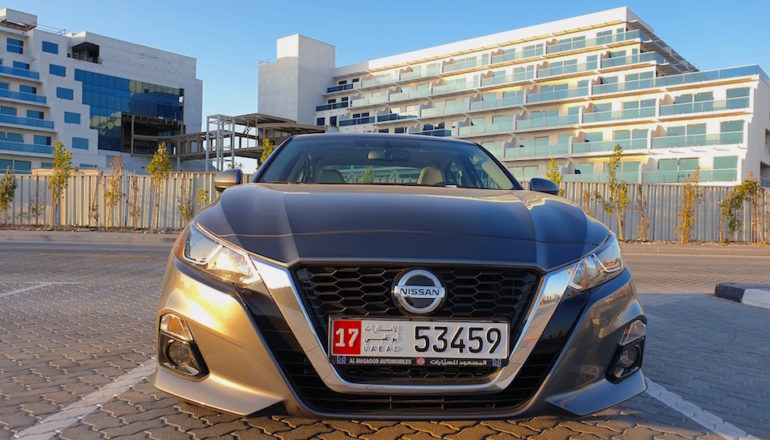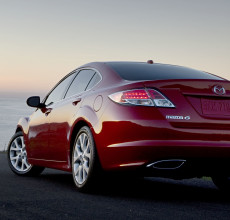The last entrant on a scene has the advantage of knowing what went ahead. Nissan Altima is the last model in its category to undergo a total overhauling in the past twelve months. So, has Nissan made use of this edge to stay ahead of its worthy rivals in the segment or has the Toyota Camry and the Honda Accord pitched their new generation way ahead already?
What is special about the sixth-generation?
- Two new engines, including the world’s first production-ready Variable Compression engine
- Advanced safety features as a part of Nissan Intelligent Mobility
- Longer, lower, wider and more athletic design
- Spacious interior design with superior materials
- Available in three trim levels in 2.5 L engine and two with the 2.0L Turbo engine starting at AED 84,000
Read what is new and find my first driving impressions at the end of this article.

The looks
Two years ago, at the NAIAS or Detroit Motor Show, Nissan unveiled its Vmotion 2.0 concept that bagged the show’s EyesOn Design Award. That concept was to be the beacon of inspiration for all upcoming sedans. Starting with the Vmotion grille and boomerang headlights, the new Altima takes plenty of cues from the show car, including the floating roof design with thin pillars celebrated in the Maxima, but has sensibly avoided the laboriously sculpted details on the flagship’s sheet metal. The new Altima comes with LED projector headlights with signature Daytime Running Lights, LED fog lights and a single panel moon-roof.
Those who love style will find many catchy changes in the Altima – The exterior colours include a deep-tinted Scarlet Ember red that changes hue with the light, and a vibrant Sunset Drift orange with a reflective pigment.
Nissan Altima have come across as the stockier one in its segment, even though a 2015 Altima and Camry were more or less exact matches in exterior dimensions. However, the sixth generation Altima is a full inch longer, 1.1 inches (2.8 cm) lower in height and 9/10th of an inch wider, with a 1.9-inch (4.8 cm) longer wheelbase. With the 19-inch rear wheels pushed further to the corners, the new model is designed to handle better with a coefficient of drag (Cd) of 0.26.

Take a look inside
The materials are superior to the sight and feel good too. Spread in front is what they call the “gliding wing” instrument panel – of course the way it looks and may be because it is lighter too – which takes after the V-motion grille design.
A 7.0-inch Advanced Drive Assist Display is standard. The seats come with Enhanced NASA-inspired Zero Gravity seat design (The principle is that in a weightless environment [read zero-gravity] the spine assumes the most favourably erect posture, avoiding the slouch that happens due to our own weight burden. This natural posture Nissan says will reduce long drive fatigue.) with dual-density foam and added bolstering for improved holding and support. The synthetic fabric looks and feels good but perforated leather inserts are available on top trims. In the new generation, the driver seat can be adjusted in 8 ways and can memorize settings. Where available, ‘remote engine start’ allows for the AC to keep the cabin ready for you and features Intelligent Climate Control.
2019 Altima is fair when it comes to connectivity – it comes with both Apple CarPlay™ and Android Auto™ besides an 8-inch multi-touch colour display, Bluetooth® Hands-free Phone System and Streaming audio via Bluetooth®. The top trim gets a Bose® Premium Audio system with nine speakers.
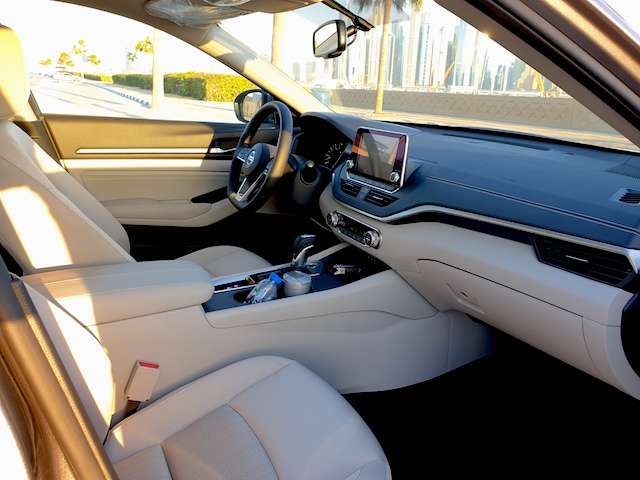
The drive gets better
There is a new all-wheel drive system and that improves traction in all conditions. The 2019 Altima range also gets enhanced suspension, steering and chassis control systems. The suspension is adjusted to improve steering feedback and vehicle response without adding to the harshness and also gets monotube rear shocks adding to the ride comfort. The chassis also has been tweaked for more comfort and confidence in controlling the car.
The steering system has been upgraded to a new dual-pinion electric power steering design – so turning the steering has become easier at low speeds while more input is required at higher speeds for improved feedback and control. The steering has a flat-bottomed shape now to match these improvements!
Some bits of the technology in Maxima have found their way into the 2019 Altima. Intelligent Ride Control (balances the up and down movement of the car when tackling bumps), Intelligent Trace Control (automatically applies brake to individual wheels to keep the driving line of the car while tackling corners) and Vehicle Dynamics Control (stability control) work together to make the drive more enjoyable and effective. The new Altima offers 16-inch, 17-inch and 19-inch wheel sizes.
Find my first driving impressions at the end of this article.

Two new engines for the Altima
This is the first time Nissan is bringing up two new engines for a model change – speaks volumes about the significance of Altima in their scheme of things.
Altima has been launched with a 2.5-liter DOHC inline 4-cylinder direct injection engine which has 80% new or redesigned parts, adding 9 hp and 4 Newton-metres to the earlier engine’s power output. The 2.5 L engine works up 188 horsepower and 244 Nm of torque. The new engine is improved with regard to noise, vibration and harshness, fuel economy and has cleaner emissions.
For the techies here are the key changes about the engine – those who want to move on can skip this paragraph. Another reason for the new Altima to be quieter is that it has a lower profile because it uses a “reverse” cylinder head with integrated exhaust manifold and low engine mounting into the new platform’s engine bay.) The engine now has a thermal-insulated resin intake port, Direct Injection Gasoline (DIG™) system, variable tumble control valve, mirror bore cylinder coating, variable displacement oil pump, intake e-VTC and cooled external EGR (Exhaust Gas Recirculation).
Find my first driving impressions at the end of this article.
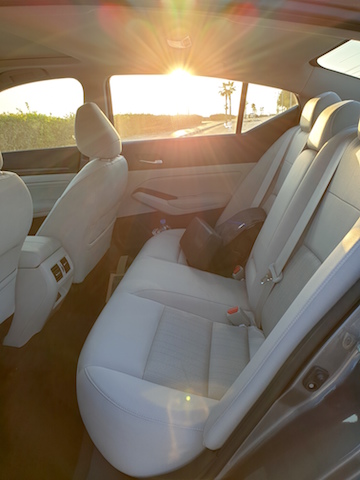
What’s coming – world’s first production Variable Compression Turbo engine
The Nissan Altima won’t have the 3.5 L V6 anymore but it isn’t going to be missed. Coming this summer is a new turbo charged engine –Nissan calls it VC Turbo, and was launched in the Infiniti QX50 as a world-first production-ready variable compression turbo inline 4-cylinder. The aim is to get closest to V6 performance but with 4-cylinder economy and this is done by seamlessly changing the compression ratio between dynamic and efficient performance settings. The engine character is balanced by how hard or soft the driver accelerates.
Compared with the previous 3.5-liter V6 engine, the 2.0-liter VC-Turbo takes less space in the engine bay and delivers 248 horsepower and 370 Nm of torque when you use premium fuel. For the V6, these figures were 270 and 340 respectively. The new 2.0-liter VC-Turbo engine is expected to improve the highway efficiency by more than 10% for the front-wheel drive models. The new VC-Turbo is earmarked for the top two grades (SV and SL) and the driver can see the changes for themselves on a gauge in the 7.0-inch Advanced Drive Assist Display.
Again, this paragraph is for techies. Interestingly, Nissan says the VC-Turbo has been in development for 20 years. The compression ratio of the new engine keeps changing smoothly between 8:1 (for high performance) and 14:1 (for high efficiency) – with an advanced multi-link system continuously raising or lowering the pistons’ reach to transform the compression ratio. If you didn’t know, while high compression ratio gives greater efficiency, sometimes there is the risk of firing too early (knocking). A low compression ratio avoids knocking by allowing greater torque. The Direct Injection Gasoline (DIG™) system improves combustion efficiency and performance and enables the engine to avoid knocking at higher compression ratios, while the multi-point injection mixes fuel and air earlier, making for a more complete combustion in the chamber, for greater efficiency at low engine loads. The VC-Turbo engine is assembled in Japan and its multi-link components are made of high-carbon steel alloy.
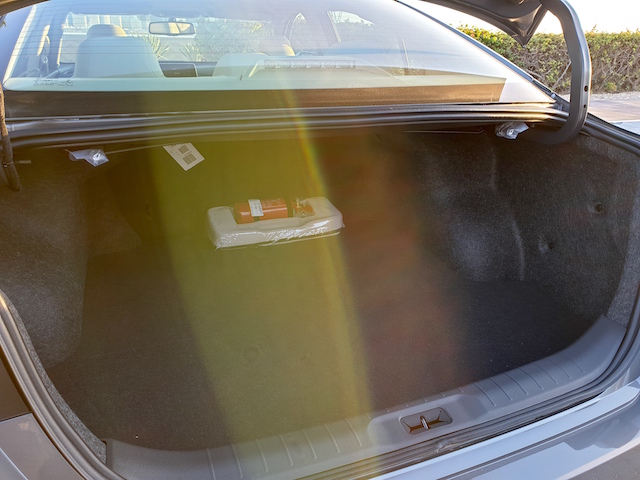
First Look. First Drive.
The Altima looks larger and more sophisticated than earlier without the laboured design details of the Maxima. The driver assistance technology is on par with the more tech-savvy models in its segment. The multimedia screen at the centre appeared dull and grey initially; in glaring light sometimes it could be it hard to read but while passing through a tunnel the screen turned to a pleasing blue and clearly visible.
There is more space for the rear passengers and also a deep and sufficient boot compartment. The slightly wish-washy feeling that marked some parts of the drive earlier has given way to a more accurate and enjoyable one. The mission of diluting the “CVT” feeling is relentlessly on in the Nissan camp and this time the gearshift emulates a 7-speed shift – faking it is getting better with time – there is very little of the bawling climb and the shift breaks its climbing feeling momentarily before going on to feel like an automatic step-transmission. Rather unnecessary if you ask me but then this concept of CVT-hating takes time to wither away and Nissan Altima has got a step closer, again!

